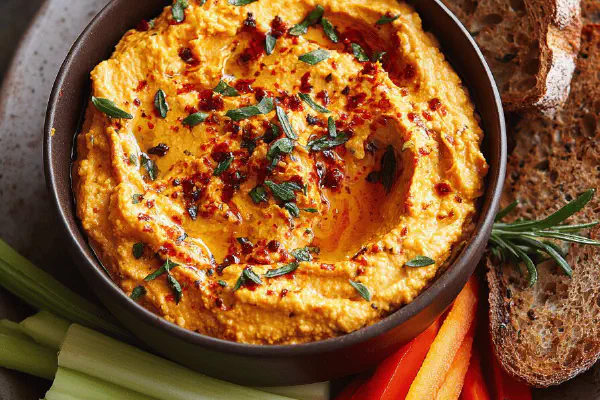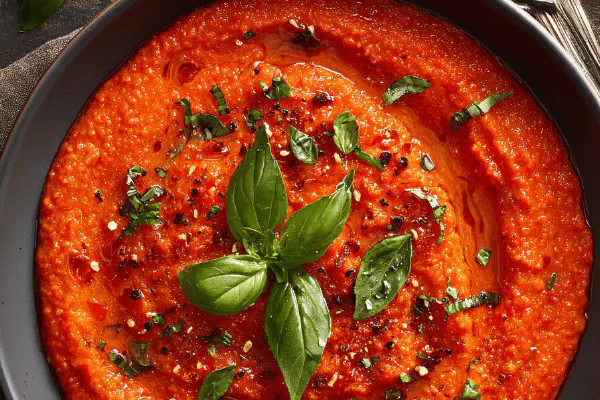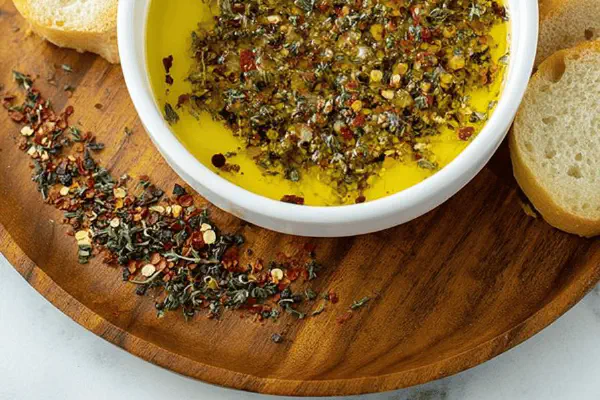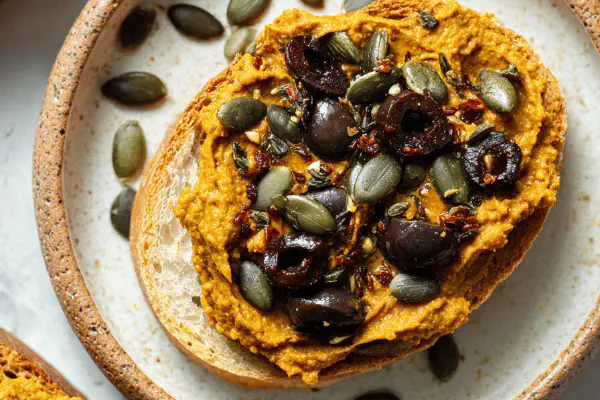Charred Red Pepper Dip

By Emma
Certified Culinary Professional
Ingredients
- 3 large red bell peppers, halved, seeds removed
- 1 large golden bell pepper, halved, seeds removed
- 50 ml olive oil, plus more for brushing
- 7 ml (1 1/2 tsp) sherry vinegar
- 1/2 tsp smoked paprika
- Salt and freshly ground black pepper
About the ingredients
Method
- Set oven rack center; preheat oven to 185 C 365 F. Line baking sheet with parchment.
- Brush peppers' skin side lightly with olive oil; skin side up on sheet. Roast about 45–55 minutes. Watch for skin blistering, bubbling, patchy char edges that crackle with heat. Peppers should char unevenly but not blacken solid; best sign is skin loosening from flesh with a faint smoky aroma.
- Immediately transfer hot peppers into airtight container or bowl covered tightly with plastic wrap—traps steam. Let cool 10–15 minutes; skin softens, peeling becomes easy.
- Peel skin carefully using fingers or paring knife; discard skin. Pat dry any excess moisture with paper towel to avoid watery dip.
- In food processor, add peeled peppers, remaining olive oil, sherry vinegar, smoked paprika. Pulse briefly until mixture looks creamy but retains some texture; avoid overblending — slight chunkiness is good.
- Taste, season with salt and pepper incrementally; remember vinegar sharpness and paprika's smoky warmth rise after resting.
- Transfer to serving bowl. Drizzle small olive oil swirl on top if desired. Serve with crusty bread or raw veggie sticks.
- Store leftovers covered in fridge up to 5 days. If dip separates, stir gently before serving.
Cooking tips
Chef's notes
- 💡 Roasting peppers skin side up on parchment. Key is blistering then crackling sounds. Watch skin bubble then loosen. Not blackened solid black. When you start smelling smoky sweetness, timing’s close. Oven temp steady 185 C / 365 F. Rushing ruins texture — mush or burnt skin. If unsure, poke skin to test softness before pulling.
- 💡 Peeling peppers right after roasting by trapping steam. Wrap or cover tightly while still hot — mini sauna effect loosens skin tightness easily. No steam trap? Reheat in hot water or under broiler few seconds. Peeling cold, tough and frustrating. Use fingers or paring knife. Keep towel handy to pat dry or dip water will be runny, watery mess.
- 💡 Blending: pulse only. Avoid puree smoothness. Aim for chunkier texture, rustic feel. Overblending kills character. Use food processor. No processor? Blender or immersion blender fine. Just pulse short bursts. Adds slight texture, crunchiness. Blend last — salt and pepper after. Vinegar sharpness needs balancing at end, small increments best.
- 💡 Ingredient swaps: golden bell pepper cuts acidity and adds sweetness. No golden? Use yellow or orange bell for similar effect. Sherry vinegar provides nutty depth but aged balsamic or red wine vinegar ok if careful with quantity — don’t overdo sourness. Smoked paprika optional but really shifts flavor profile; leave in if possible.
- 💡 Storage and reuse: store covered airtight in fridge up to 5 days. If separation happens, stir gently before serving. Leftover dip improves after resting flavors mingle but check seasoning again before serving cold or room temp. Watery dip means excess moisture on peppers or not patted dry well.
Common questions
Why peel peppers after roasting?
Peeling removes bitter blistered skin. Skin loosens after steam trap step. Otherwise tough, chewy. Too early peel equals frustration - cold tight skin resists removal. Steam softens skin. Helps texture balance in dip. Works best wrapping hot peppers in airtight container or covered bowl.
Can I substitute another vinegar?
Yes but watch quantity. Sherry vinegar gives depth, nutty note. Use aged balsamic for sweeter twist or red wine vinegar for sharper flavor. Too much vinegar makes dip sour flat no balance. Start small increments, taste along. Adjust seasoning after blending, not before.
What if my peppers won’t peel?
Reheat quickly in hot water or broiler few seconds. Steam trap not done right? Skin stays stuck. Peeling frozen or cold peppers also harder. Patience and warmth key. Using paring knife gently under skin edges helps. Avoid heavy scrubbing that breaks pepper flesh.
How long does dip keep?
Fridge max 5 days sealed airtight. Separation may happen — give gentle stir before serving. Freeze not recommended, texture suffers. If dip smells off or mold appears discard immediately. Keep refrigerated promptly after serving to avoid spoilage.



